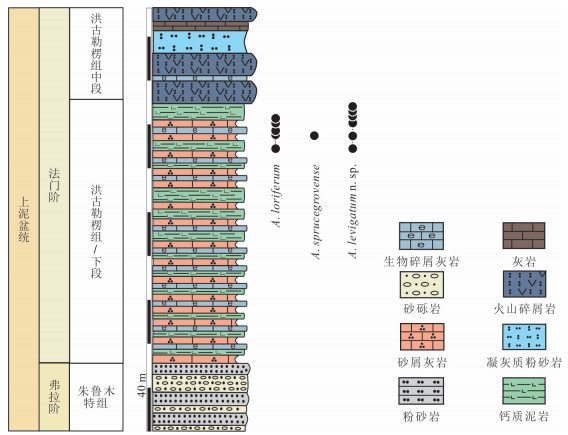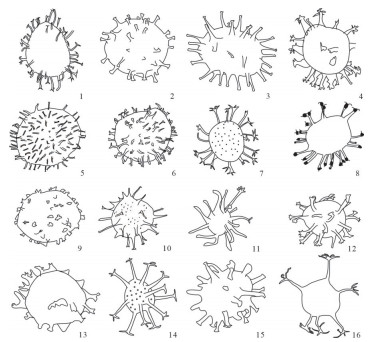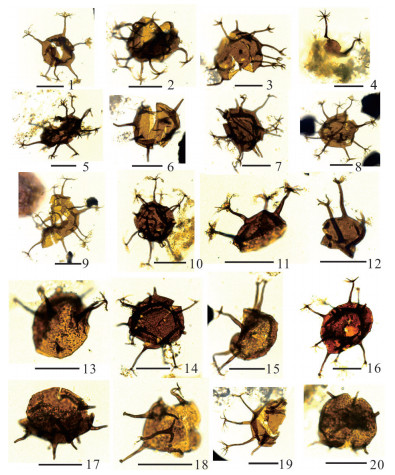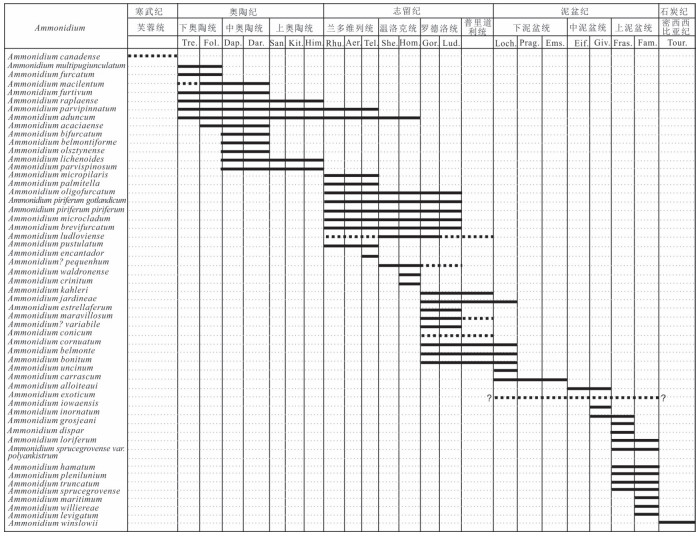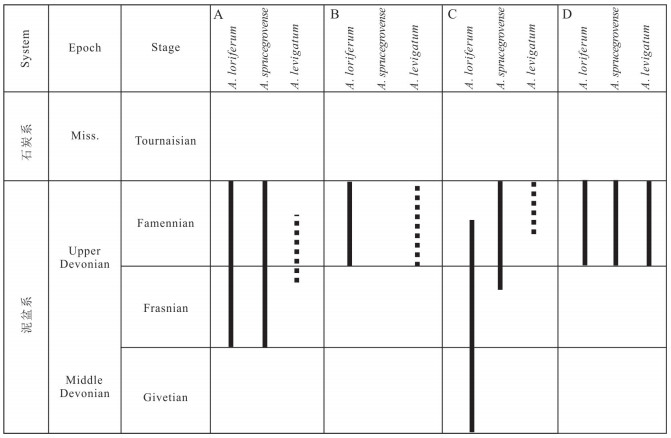Taxonomic Reconsideration of Ammonidium Lister 1970 and Related Species and Its Biostratigraphical and Palaeogeographical Implication
-
摘要: 许多可归为疑源类Ammonidium Lister 1970的种被前人划为Multiplicisphaeridium
Staplin,1961 、Baltisphaeridium Eisenack 1958 ex Eisenack 1959及其他相似属,在某种程度上缩小了其原有定义范围. 报道了采自新疆西准噶尔洪古勒楞组下段保存良好的Ammonidiumloriferum、A. sprucegrovense,通过相关文献引证对比,并结合剖面部分该属标本化石,对Ammonidium属征作了修订.根据新属征特点,将CaiacorymbiferTappan and Loeblich, 1971 ,GracilisphaeridiumEisenack and Cramer, 1973 ,NaevisphaeridiumWicander, 1974 , PuteoscortumWicander and Loeblich, 1977 ,CraterisphaeridiumDeunff, 1981 ,Pertusisphaeridium Turner,1986 和MartinsphaeridiumSarjeant and Vavrdová,1997 等相似属纳入Ammonidium属的晚出异名.Ammonidium sprucegrovense var. polyankistrumWicander and Loeblich, 1977 由种级降为了变种级.建立1个新种:Ammonidium levigatum n. sp.,前人报道的部分标本被误归为A.loriferum或A. sprucegrovense.新种Ammonidium levigatum n. sp.在全球晚泥盆世古大陆边缘具有全球分布特征,是识别晚泥盆世疑源类的标准化石之一.Abstract: Many species that can be attributed to AmmonidiumLister, 1970 have been differently assigned to MultiplicisphaeridiumStaplin, 1961 , Baltisphaeridium Eisenack, 1958 ex Eisenack, 1959 and other similar genera, which, to some extent, narrowed the original definition. The diagnosis of Ammonidium is emended here in based on reference comparison and some Ammonidium taxa collected recently from the lower part of the Hongguleleng Formation, NW Xinjiang. This paper considers CaiacorymbiferTappan and Loeblich 1971 , GracilisphaeridiumEisenack and Cramer 1973 , Naevisphaeridium Wicander 1974, PuteoscortumWicander and Loeblich 1977 , Craterisphaeridium Deunff 1981, Pertusisphaeridium Turner 1986, and MartinsphaeridiumSarjeant and Vavrdová 1997 are junior synonyms of Ammonidium. The taxonomical ranks of Ammonidium sprucegrovense var. polyankistrumWicander and Loeblich, 1977 are changed from the species to the varietas level. A new species is proposed, i.e., Ammonidium levigatum n. sp., which may have been erroneously identified as A.loriferum (Deunff)Hashemi and Playford 1998 or A. sprucegrovense(Staplin) Lister 1970 in many publications.Ammonidium levigatum n. sp. is widely distributed in the margins ofpalaeocontinents and is an important stratigraphical index fossil for the Late Devonian.-
Key words:
- Ammonidium /
- acritarchs /
- taxonomy /
- biostratigraphy /
- palaeogeography /
- palaeobiology /
- NW China
-
图 1 (a) 晚泥盆世古地理图(修改自Boucot et al., 2013),显示孢粉样品采集地哈萨克斯坦板块的位置;(b)研究剖面在新疆的位置; (c)根那仁剖面所在详细位置及西准噶尔上泥盆统出露情况
Fig. 1. (a) Late Devonian palaeogeographic map(modified from Boucot et al., 2013), showing the location of the Kazakhstan plate where palynological samples have been collected; (b) the geographical location in Xinjiang; (c) Detailed location of the studied section and Upper Devonian outcrops of Western Junggar
图 3 Ammonidium属部分重要种素描图
Fig. 3. Idealized line drawings of selected Ammonidium species described from literature
1. Ammonidium grosjeani(Stockmans and Williere, 1962a) Martin(1981); 2. A. alloiteaui(Deunff, 1955) Martin, (1981);3. A. waldronense(Tappan and Loeblich, 1971) Dorning(1981); 4. A. multipugiunculatum(Cramer and Díez, 1977)Rubinstein(in Rubinstein et al., 1999); 5. A. lewisii Lister(1970); 6. A. aduncum Playford and Martin(1984); 7. A. loriferum(Deunff) Hashemi and Playford(1998); 8. A. maravillosum(Cramer, 1969) Thusu; 9. A. furtivum Playford and Martin(1984); 10. A. microcladum(Downie, 1963) Lister(1970); 11. A. iowaensis Wicander and Wood(1997); 12. A. uncinum Loeblich and Wicander(1976); 13. A. conicum Pöthe de Baldis(1998); 14. A. sprucegrovense Martin(1981); 15. A. cornuatum Loeblich and Wicander(1976); 16. A.levigatum n. sp.
图版1 所有标本均采自新疆西准噶尔根那仁剖面洪古勒楞组下段上部
1~12. Ammonidium levigatumsp. nov.1. GNR62⁃92, 237.7 m; 2. GNR58⁃2, 224.7 m; 3. GNR58⁃33, 224.7 m; 4. GNR50⁃98, 224.7 m; 5. GNR55⁃3, 216.1 m; 6. GNR58⁃1, 224.7 m; 7. GNR58⁃25, 224.7 m; 8. GNR62⁃4, 237.7 m; 9. GNR62⁃5, 237.7 m; 10. GNR62⁃2, 237.7 m; 11. GNR62⁃91, 237.7 m; 12. GNR58⁃5, 224.7 m; 13~18. Ammonidium loriferum(Deunff) Hashemi and Playford(1998). 13. GNR50⁃5, 200 m; 14. GNR50⁃4, 200 m; 15. GNR55⁃1, 216.1 m; 16. GNR50⁃1, 200 m; 17. GNR61⁃1, 234.2 m; 18. GNR61⁃1, 234.2 m; 19. Ammonidium sprucegrovense, GNR55⁃4, 216.1 m; 20. Ammonidium sp., GNR50⁃96, 200 m (图中比例尺=20 μm)
图版1. All the samples were collected at the upper part of the lower member of the Hongguleleng Fm. from the Gennaren section
图 6 Ammonidium在中奥陶世(a)、志留纪(b)和晚泥盆世(c)古地理复原图中的分布
古地理图修改自Boucot et al.(2013)
Fig. 6. Palaeobiogeographical distribution of the Ammonidium⁃bearing assemblages on palaeogeographical reconstructions of the Middle Ordovician (a), the Silurian (b) and Late Devonian (c)
表 1 Ammonidium属已有种列表
Table 1. List of Ammonidium acritarch species described in the literature
种名 原属名 作者和年份 A. alloiteaui Micrhystridium; Baltisphaeridium; Ammonidium Deunff(1955); Martin(1981) A. belmonte Multiplicisphaeridium; Ammonidium Cramer(1970); Sarjeant and Vavrdová(1997) A. belmontiforme Multiplicisphaeridium; Ammonidium Tynni(1975); Sarjeant and Vavrdová(1997) A. carrascum Baltisphaeridium; Multiplicisphaeridium; Ammonidium Cramer(1966); Sarjeant and Vavrdová(1997) A. crinitum Micrhystridium; Multiplicisphaeridium?; Ammonidium Grishina and Klenina(1981); Sarjeant and Vavrdová(1997) A. cornuatum Ammonidium Loeblich and Wicander(1976) A. conicum Ammonidium Pöthe de Baldis(1998) A. exoticum Baltisphaeridium; Ammonidium Deunff(1965a); Lister(1970) A. furtivum Ammonidium Playford and Martin(1984) A. grosjeani Baltisphaeridium; Ammonidium Stockmans and Willière(1962a); Martin(1981) A. hamatum Ammonidium Wicander(1974) A. inornatum Ammonidium Colbath(1990) A. iowaensis Ammonidium Wicander and Wood(1997) A. lewisii Hystrichosphaeridium; Baltisphaeridium; Ammonidium Deunff(1954); Lister(1970) A. loriferum Baltisphaeridium; Ammonidium Deunff (1965b); Hashemi and Playford(1998) A. ludloviense Ammonidium Lister(1970); Dorning(1981) A. microcladum Baltisphaeridium; Ammonidium Downie(1963); Lister(1970) A. maravillosum Multiplicisphaeridium; Baltisphaeridium; Ammonidium Cramer(1969); Thusu(1973); Díez and Cramer(1977) A. maritimum Ammonidium Martin(1984) A. macilentum Ammonidium Playford and Martin(1984) A. multipugiunculatum Multiplicisphaeridium; Ammonidium Cramer and Díez(1977); Rubinstein et al.(1999) A. olsztynense Multiplicisphaeridium; Ammonidium Górka(1979); Sarjeant and Vavrdová(1997) A. palmitella Baltisphaeridium; Ammonidium Cramer and Díez(1972); Dorning(1981) A.? pequenhum Multiplicisphaeridium; Ammonidium Cramer and Díez(1972); Sarjeant and Vavrdová(1997) A. sprucegrovense Multiplicisphaeridium; Puteoscortum; Ammonidium Staplin(1961); Lister(1970) A. truncatum Multiplicisphaeridium; Ammonidium Staplin(1961); Sarjeant and Vavrdová(1997) A. uncinum Ammonidium Loeblich and Wicander(1976) A.? variabile Multiplicisphaeridium; Ammonidium Lister(1970); Sarjeant and Vavrdová(1997) A. waldronense Caiacorymbifer; Ammonidium Tappan and Loeblich(1971); Dorning(1981) 表 2 Ammonidium属新纳入的种
Table 2. Species newly included of Ammonidium in this study
种名 原属名 作者和年份 A. acaciaense Multiplicisphaeridium Playford and Martin(1984) A. bifurcatum Multiplicisphaeridium Staplin et al.(1965) A. bonitum Baltisphaeridium; Multiplicisphaeridium; Thysanoprobolus Jardiné and Yapaudjian(1968); Cramer(1970); Loeblich and Tappan(1970); Eisenack et al.(1973) A. brevifurcatum Hystrichosphaeridium; Baltisphaeridium; Multiplicisphaeridium Eisenack(1954); Downie and Sarjeant(1963); Eisenack et al.(1973) A. canadense Multiplicisphaeridium Staplin et al.(1965); Eisenack et al.(1973) A. dispar Pertusisphaeridium Turner(1986) A. estrellaferum Baltisphaeridium; Multiplicisphaeridium Cramer(1966); Eisenack et al.(1973) A. furcatum Priscogalea; Baltisphaeridium; Multiplicisphaeridium Deunff, 1961, 1964; Eisenack et al.(1973) A. encantador Baltisphaeridium; Gracilisphaeridium Cramer(1970); Eisenack et al.(1973) A. jardineae Baltisphaeridium; Multiplicisphaeridium Jardiné and Yapaudjian(1968); Cramer(1970); Eisenack et al.(1973) A. kahleri Baltisphaeridium; Multiplicisphaeridium Bachmann and Schmid(1964); Eisenack et al.(1973) A. lichenoides Multiplicisphaeridium; Martinsphaeridium Uutela and Tynni(1991); Sarjeant and Vavrdová(1997) A. micropilaris Baltisphaeridium; Multiplicisphaeridium Cramer(1970); Eisenack et al.(1973) A. oligofurcatum Hystrichosphaeridium; Baltisphaeridium; Visbysphaera; Multiplicisphaeridium Eisenack(1954); Downie(1963); Eisenack et al.(1973) A. parvipinnatum Multiplicisphaeridium; Martinsphaeridium Uutela and Tynni(1991); Sarjeant and Vavrdová1997 A. parvispinosum Multiplicisphaeridium; Martinsphaeridium Uutela and Tynni, 1991; Sarjeant and Vavrdová(1997) A. piriferumgotlandicum Multiplicisphaeridium; Baltisphaeridium Cramer(1970); Eisenack et al.(1973) A. piriferumpiriferum Hystrichosphaeridium; Baltisphaeridium; Multiplicisphaeridium Eisenack(1954); Downie and Sarjeant(1963); Eisenack et al.(1973) A. sprucegrovense var.polyankistrum var. nov. Puteoscortum Staplin(1961); Wicander and Loeblich(1977); Wicander and Playford(2013) A. plenilunium Naevisphaeridium Wicander(1974) A. pustulatum Baltisphaeridium; ?Multiplicisphaeridium Schultz(1967); Eisenack et al.(1973) A. raplaense Multiplicisphaeridium; Martinsphaeridium Uutela and Tynni(1991); Sarjeant and Vavrdová(1997) A. winslowii Gorgonisphaeridium; Multiplicisphaeridium Staplin et al.(1965); Eisenack et al.(1973) A. williereae Puteoscortum Martin(1981) 表 3 部分Ammonidium种的新分类
Table 3. New classification of selected species of Ammonidium
新种名 原种名 V* PN* PL* PB* PD* 作者和年份 Ammonidiumaduncum A. listeri 19~34 > 50 3~5 0.6 < 1 Smelror(1987) A. aduncum 33~75 > 50 2~4 0.5~2.0 ca. 1 Playford and Martin(1984) A. ballistum 38~59 > 50 3~10 1.0~1.5 < 1 Ottone et al.(1992) Ammonidiumgrosjeani A. grosjeani 24~34 35~45 10~15 1~2 0.5~3 Stockmans and Willière(1962a); Eisenack et al.(1973); Martin(1981) A. hydraferum ca. 25 30~40 8~13 2~3 3~5 Stockmans and Willière(1962a); Lister(1970) Ammonidiumlodloviense A. ludloviense 21~35 35~45 ca. 4 2~3 ca. 1 Lister(1970); Dorning(1981) M. saharicum 21~34 ca. 30 4~6 2~3 < 1 Lister(1970) Ammonidiumloriferum A. loriferum 30~40 ca. 9 15~20 3~4 4~5 Hashemi and Playford(1998) A. garrasinoi 29~40 8~10 10~20 2~3 5~6 Ottone(1996) Ammonidiumpiriferumgotlandicum M. erraticum ca. 45 ca. 25 20~30 2~3 < 1 Eisenack et al.(1973) M. piriferumgotlandicum ca. 60 ca. 22 10~18 3~5 2~10 Eisenack et al.(1973) M. gotlandicum ca. 50 > 25 ca. 6 2~3 < 1 Eisenack et al.(1973) M. piriferumhispanicum ca. 60 ca. 24 10~20 2~5 1~5 Eisenack et al.(1973) Ammonidiumpiriferumpiriferum M. piriferumpiriferum 60~90 ca. 18 15~20 5~8 1~5 Eisenack et al.(1973) Ammonidiumsprucegrovense ?A. paleozoicum ca. 30 ca. 11 ca. 10 3~5 3~5 Sarjeant and Vavrdová(1997) ?A. sprucegrovense 30~43 12~18 17~25 2~3 3~5 Martin(1981) B. microfurcatum ca. 22 15~20 12~15 3~6 ca. 6 Deunff(1957); Fensome et al.(1990) Ammonidiumsprucegrovense var. polyankistrum Puteoscortumpolyankistrum 38~58 15~18 13~24 2.5~5.0 3~8 Wicander and Loeblich(1977) 注:V. 膜壳直径(diameter of the vesicle);PN. 突起的数量(number of processes);PL. 突起的长度(length of the processes);PB. 突起基部的直径(diameter of the bases of the processes);PD. 突起末端的直径(diameter of the distal end of the processes) -
Bachmann, A., Schmid, M.E., Prey, S., 1964. Mikrofossilienaus dem Österreichischen Silur. Verhandlungen der Geologischen Bundesanstalt, 1: 53-64. Boucot, A.J., Chen, X., Scotese, C.R., et al., 2013. Phanerozoic Paleoclimate: An Atlas of Lithologic Indicators of Climate. Society for Sedimentary Geology, Tulsa, 478. Calner, M., Kozłowska, A., Masiak, M., et al., 2006. A Shoreline to Deep Basin Correlation Chart for the Middle Silurian Coupled Extinction-Stable Isotopic Event. GFF, 128(2): 79-84. https://doi.org/10.1080/11035890601282079 Colbath, G.K., 1990. Devonian (Givetian-Frasnian) Organic-Walled Phytoplankton from the Limestone Billy Hills Reef Complex, Canning Basin, Western Australia. Palaeontographica Abteilung B Paläophytologie, 217(4-6): 87-145. Cramer, F.H., 1966. Palynology of Silurian and Devonian Rocks in Northwest Spain. Boletin del institutoGeológico y Minero de España, 77: 225-286. Cramer, F.H., 1969. Possible Implications for Silurian Paleogeography from Phytoplancton Assemblages of the Rose Hill and Tuscarora Formations of Pennsylvania. Journal of Paleontology, 43: 485-491. Cramer, F.H., 1970. Distribution of Selected Silurian Acritarchs: An Account of the Palynostratigraphy and Paleogeography of Selected Silurian Acritarch Taxa, Revista Española de Micropalaeontológia, númeroextraordinario, 1: 1-203. Cramer, F.H., Díez, M.D.C.R., 1972. North American Silurian Palynofacies and Their Spatial Arrangement: Acritarchs. Palaeontographica Abteilung B, 138: 107-180. Cramer, F.H., Díez, M.D.C.R., 1974. Silurian Acritarchs: Distribution and Trends. Review of Palaeobotany and Palynology, 18: 137-154. https://doi.org/10.1016/0034-6667(74)90014-1 Cramer, F. H., Díez, M.D.C.R., 1977. Late Arenigian (Ordovician) Acritarchs from Cis-Saharan Morocco. Micropaleontology, 23(3): 339-360. doi: 10.2307/1485220 Cunhá, T.A., Oliveira, J.T., 1989. Upper Devonian Palynomorphs from the Represa and Phyllite-Quartzite Formations, Mina de São Domingos region, Southeast Portugal: Tectonostratigraphic Implications. Bulletin de la Société Géologique de Belgique, 98: 295-309. Deunff, J., 1954. Microorganismes Planctoniques (Hystrichosphères) dans le Dévonien du Massif Armoricain. Compte rendusommaire des séances de la Société géologique de France, 11: 239-242. Deunff, J., 1955. Un Microplancton Fossile Dévonien à Hystrichosphères du Continent Nord-Américain. Bulletin de Microscopie Appliquée, 2(5): 11-12. Deunff, J., 1957. Microorganismes Nouveaux (Hystrichosphères) du Dévonien de l'Amérique du Nord. Bulletin de la Société Géologique et Mineralogique de Bretagne, Nouvelle Sér, 2: 5-14. Deunff, J., 1961. Un Microplancton à Hystrichosphères dans le Trémadoc du Sahara. Revue de Micropaléontologie, 4: 37-52. Deunff, J., 1964. Sur unesérie à Acritarches dans le Dévonienmoyen du Finistère. Bureau de Recherches Géologiques et Minières, Mémoire, 33: 341-348. Deunff, J., 1965a. Recherches sur les Microplanctons du Dévonien (Acritarches et Dinophyceae). Résumé du MémoirePrésentédevant la Faculté des Sciences de Rennes pour Obtenir le Grade de Docteur de l''Université de Rennes', pp. 92. Deunff, J., 1965b. Acritarches du Dévoniensupérieur de la Presqu'île de Crozon. Compte Rendu Sommaire des Séances de la Société Géologique de France, 5: 162-164. Deunff, J., 1981. Observations Préliminaires sur le Paléophytoplancton de la Coupe de Caffiers (Givétien-Frasnien de Boulonnais, France). Annales de la Société Géologique du Nord, 100: 65-71. de Andrade, C.L.N., Cardoso, T.R.M., Santos, R.R., et al., 2020. Organic Facies and Palynology from the Middle to Late Devonian of the Pimenteiras Formation, Parnaíba Basin, Brazil. Journal of South American Earth Sciences, 99: 102481. https://doi.org/10.1016/j.jsames.2019.102481 de Inunciaga, M.F., Gutiérrez, P.R., 2011. Silurian Microplankton from the Cachipunco Formation (Santa Bárbara Range; Andina Central Basin), Jujuy, Argentina. Revista del Museo Argentino de Ciencias Naturales, 13(2): 147-174. di Pasquo, M., Grader, G.W., Warren, A., et al., 2017. Palynologic Delineation of the Devonian-Carboniferous Boundary, West-Central Montana, USA. Palynology, 41(sup1): 189-220. https://doi.org/10.1080/01916122.2017.1366180 di Pasquo, M., Noetinger, S., Isaacson, P., et al., 2015. Mid-Late Devonian Assemblages of Herbaceous Lycophytes from Northern Argentina and Bolivia: Age Assessment with Palynomorphs and Invertebrates and Paleobiogeographic Importance. Journal of South American Earth Sciences, 63: 70-83. https://doi.org/10.1016/j.jsames.2015.06.010 Díez, M.D.C.R., Cramer, F.H., 1977. Range Chart of Selected Lower Paleozoic Acritarch Taxa. Ⅱ. Index to Parts Ⅰ and Ⅱ. Review of Palaeobotany and Palynology, 24: 1-48. https://doi.org/10.1016/0034-6667(77)90016-1 Dorning, K.J., 1981. Silurian Acritarchs from the Type Wenlock and Ludlow of Shropshire, England. Review of Palaeobotany and Palynology, 34(2): 175-203. https://doi.org/10.1016/0034-6667(81)90037-3 Downie, C., 1963. 'Hystrichospheres' (Acritarchs) and Spores of the Wenlock Shales (Silurian) of Wenlock, England. Palaeontology, 6(4): 625-652. Downie, C., Sarjeant, W.A.S., 1963. On the Interpretation and Status of Some Hystrichosphere Genera. Palaeontology, 6(1): 83-96. Eisenack, A., 1954. Hystrichosphärenaus dem BaltischenGotlandium. Senckenbergiana, 34: 205-211. Eisenack, A., Cramer, F.H., Díez, M.D.C.R., 1973. Katalog der FossilenDinoflagellaten, Hystrichosphären und VerwandtenMikrofossilien. Band Ⅲ, Acritarcha I. Stuttgart: E. Schweizerbart' sche Verlagsbuchhhandlung, Stuttgart, 1-1104. Eisenack, A., Cramer, F.H., Díez, M.D.C.R., 1976. Katalog der Fossilen Dinoflagellaten, Hystrichosphären und Verwandten Mikrofossilien. Band IV, Acritarcha 2. Stuttgart: E. Schweizerbart' sche Verlagsbuchhhandlung, Stuttgart. Eley, B.E., Legault, J.A., 1992. Acritarchs from the Fossil Hill Formation (Silurian) of Southern Ontario, Canada. Palynology, 16(1): 73-92. https://doi.org/10.1080/01916122.1992.9989408 Eriksson, K., Hagenfeldt, S.E., 1997. Acritarch Assemblages from the Lower Silurian (Llandovery-Wenlock) in the Grötlingboborrningen 1 Core, Gotland, Sweden. GFF, 119(1): 13-16. https://doi.org/10.1080/11035899709546448 Evitt, W.R., 1963. A Discussion and Proposals Concerning Fossil Dinoflagellates, Hystrichospheres, and Acritarchs, I. Proceedings of the National Academy of Sciences of the United States of America, 49: 158-164. doi: 10.1073/pnas.49.2.158 Fensome, R.A., Williams, G.L., Barss, M.S., et al., 1990. Acritarchs and Fossil Prasinophytes: An Index to Genera, Species and Infraspecific Taxa. American Association of Stratigraphic Palynologist Contribution Series, 25: 1-771. Filipiak, P., 2005. Late Devonian and Early Carboniferous Acritarchs and Prasinophytes from the Holy Cross Mountains (Central Poland). Review of Palaeobotany and Palynology, 134(1): 1-26. https://doi.org/10.1016/j.revpalbo.2004.11.001 García-Muro, V.J., Rubinstein, C.V., 2015. New Biostratigraphic Proposal for the Lower Palaeozoic Tucunuco Group (San Juan Precordillera, Argentina) Based on Marine and Terrestrial Palynomorphs. Ameghiniana, 52(2): 265-285. https://doi.org/10.5710/AMGH.14.12.2014.2813 Ghavidel-Syooki, M., 1996. Acritarch Biostratigraphy of the PalaeozoicRock Units in the Zagros Basin, Southern Iran. Acta Universitatis Carolinae Geologica, 40: 385-411. Ghavidel-Syooki, M., 2001. Palynostratigraphy and Paleogeography of the Late Devonian in Northeastern Esfahan City, Central Iran. In: Goodman, D.K., Clarke, R.T., eds., Proceedings of the IX International Palynological Congress, Houston, Texas, 1996. American Association of Stratigraphic Palynologists Foundation, Dallas, 37-51. Ghavidel-Syooki, M., 2006. Palynostratigraphy and Palaeogeography of the Cambro-Ordovician Strata in Southwest of Shahrud City (Kuh-e-Kharbash, Near Deh-Molla), Central Alborz Range, Northern Iran. Review of Palaeobotany and Palynology, 139: 81-95. https://doi.org/10.1016/j.revpalbo.2005.07.006 Ghavidel-Syooki, M., Owens, B., 2007. Palynostratigraphy and Palaeogeography of the Padeha, Khoshyeilagh, and Mobarak Formations in the Eastern Alborz Range (Kopet-Dagh Region), Northeastern Iran. Revue de Micropaléontologie, 50(1): 129-144. doi: 10.1016/j.revmic.2007.01.004 González, F., Moreno, C., Playford, G., 2005. Upper Devonian Biostratigraphy of the Iberian Pyrite Belt, Southwest Spain-Part Two: Organic-Walled Microphytoplankton. Palaeontographica Abteilung B, 273: 53-86. doi: 10.1127/palb/273/2005/53 González, F., Moreno, C., Melgarejo, J. C., et al., 2015. Palynological Age Constraint of Les VilellesUnit, Catalan Coastal Chain, Spain. Geologica Acta: An International Earth Science Journal, 13(4): 345-361. Górka, H., 1979. Les Acritarches de l'OrdovicienMoyen d'Oisztyn IG 2 (Pologne). Acta Palaeontologica Polonica, 24(3): 351-376. Gray, J., Boucot, A.J., Grahn, Y., et al., 1992. A New Record of Early Silurian Land Plant Spores from the Parana Basin, Paraguay (Malvinokaffric Realm). Geological Magazine, 129(6): 741-752. https://doi.org/10.1017/S0016756800008463 Grishina, T.S., Klenina, L.N., 1981. Akritarkhiiz Zony Cyrtograptus Lundgreni Skladchatoi Sistemy. Khabarpary Izvestiya Akademii Nauk Kasakhskoi SSR, Seriya Geologicheskaya, Kazakhskoifiliel Alma-Ata, 1: 26-34. Hashemi, H., Playford, G., 1998. Upper Devonian Palynomorphs of the Shishtu Formation, Central Iran Basin, East-Central Iran. Palaeontographica Abteilung B, 246: 115-212. Higgs, K.T., Williams, B.P., 2011. Palynology and Palaeoenvironments of the Silurian Coosglass Slate and Ferriter's Cove Formations in the Dunquin Inlier (Dingle Peninsula, Ireland). Geological Quarterly, 55: 95-108. Hill, P.J., 1974. Stratigraphic Palynology of Acritarchs from the Type Area of the Llandovery and the Welsh Borderland. Review of Palaeobotany and Palynology, 18(1-2): 11-23. https://doi.org/10.1016/0034-6667(74)90004-9 Jachowicz, M., 2000. Acritarch Assemblages from the Silurian Pomeranian Caledonides and Their Foreland. Geological Quarterly, 44(3): 317-331. Jankauskas, T., Gritytë, J., 2004. Upper Llandoverian and Lower Wenlockian Acritarch Assemblages from the Ledai-179 Boring in Lithuania. Geologija, 48: 38-43. Jardiné, S., Yapaudjian, L., 1968. Lithostratigraphie et palynologie du Dévonien-Gothlandien Gréseux du Bassin de Polignac (Sahara). Revue de l'Institut Français du Pétrole, 23(4): 439-469. Keegan, J.B., Rasul, S.M., Shaheen, Y., 1990. Palynostratigraphy of the Lower Palaeozoic, Cambrian to Silurian, Sediments of the Hashemite Kingdom of Jordan. Review of Palaeobotany and Palynology, 66(3-4): 167-180. https://doi.org/10.1016/0034-6667(90)90037-J Kimpe, W.F.M., Bless, M.J.M., Bouckaert, J., et al., 1978. Paleozoic Deposits East of the Brabant Massif in Belgium and the Netherlands. Mededelingen-Rijks Geologische Dienst, 30(2): 37-103. Kroeck, D.M., Blanchon, M., Zacaï, A., et al., 2020. Revision of the Cambro-Ordovician Acritarch Genus Vulcanisphaera Deunff, 1961. Review of Palaeobotany and Palynology, 104212. https://doi.org/10.1016/j.revpalbo.2020.104212 Lakova, I., Göncüoğlu, M.C., 2005. Early Ludlovian (Early Late Silurian) Palynomorphs from the Palaeozoic of Camdag, NW Anatolia, Turkey. Journal of the Earth Sciences Application and Research Centre of Hacettepe University, 26(1): 61-73. Le Hérissé, A.L., 1989. Acritarches et Kystesd'Algues Prasinophycées du Silurien de Gotland, Suède. Palaeontographia Italica, Memorie di Paleontologia, 76: 57-302. Le Hérissé, A., Al-Tayyar, H., van der Eem, H., 1995. Stratigraphic and Paleogeographical Significance of Silurian Acritarchs from Saudi Arabia. Review of Palaeobotany and Palynology, 89(1-2): 49-74. https://doi.org/10.1016/0034-6667(95)00041-U Le Hérissé, A.L., Gourvennec, R., Wicander, R., 1997. Biogeography of Late Silurian and Devonian Acritarchs and Prasinophytes. Review of Palaeobotany and Palynology, 98: 105-124. https://doi.org/10.1016/S0034-6667(97)00021-3 Le Hérissé, A.L., Servais, T., Wicander, R., 2000. Devonian Acritarchs and Related Forms. Courier Forschungsinstitut Senckenberg, 20: 195-205. Lei, Y., Servais, T., Feng, Q., et al., 2013. Latest Permian acritarchs from South China and the Micrhystridium/Veryhachium Complex Revisited. Palynology, 37(2): 325-344. https://doi.org/10.1080/01916122.2013.793625 Li, J., Servais, T., 2002. Ordovician Acritarchs of China and Their Utility for Global Palaeobiogeography. Bulletin de la Société Géologique de France, 173: 399-406. doi: 10.2113/173.5.399 Li, M., Wang, Z.F., Yao, Z.L., 2021. Microfossils and Paleoenvironmental Significance of Late Paleoproterozoic Ruyang Group in South Margin of North China Craton: Evidence from Microstructure and Biomarker. Earth Science, 46(11): 4072-4083(in Chinese with English abstract). Lister, T.R., 1970. The Acritarchs and Chitinozoa from the Wenlock and Ludlow Series of the Ludlow and MillichopeAreas, Shropshire. Part 1. Palaeontographical Society Monographs. Palaeontographical Society, London, 1-100. Loeblich, A.R., Tappan, H. 1970. Thysanoprobolus, ANew Acritarch Genus from the Early Devonian (Late Gedinnian) Haragan Formation of Oklahoma, U.S.A. Biological Society of Washington Proceedings, 83: 261-266. Loeblich, A.R., Wicander, E.R., 1976. Organic-Walled Microplankton from the Lower Devonian Late Gedinnian Haragan and Boisd'Arc Formations of Oklahoma, USA, Part 1. Palaeontographica Abteilung B, 159: 1-39. Lu, L.C., Wicander, R., 1988. Upper Devonian Acritarchs and Spores from the Hongguleleng Formation, Hefeng District in Xinjiang, China. Revista Española de Micropaleontología, 20: 109-148. Ma, X.P., Zong P., Zhang Y.B., et al., 2013. Subdivision of Famennian (Late Devonian) Strata in the Northwest Border of the Junggar Basin, Xinjiang, Northwestern China. Earth Science Frontiers, 20(6): 255-268 (in Chinese with English abstract). Ma, X.P., Zhang, M., Zong, P., et al., 2017. Temporal and Spatial Distribution of the Late Devonian (Famennian)Strata in the Northwestern Border of the Junggar Basin, Xinjiang, Northwestern China. Acta Geologica Sinica (English Edition), 91: 1413-1437. https://doi.org/10.1111/1755-6724.13370 Martin, F., 1981. Acritarches du Faménnien Inférieur à Villers-sur-Lesse (Belgique), Bulletin de l'Institut Royal des Sciences Naturelles de Belgique. Sciences de la Terre, 52: 1-49. Martin, F., 1982. Acritarches et Chitinozoaires de la PartieSupérieuré du Frasnien dans un Affleurement au Nord Immediat de Frasnes (Belgique), Bulletin de l'Institut Royal des Sciences Naturelles Belgique, Sciences de la Terre, 54: 1-17. Martin, F., 1984. Acritarches du FrasnienSuperieur et du FamennienInferieur du Bord Meridional du Bassin de Dinant (Ardennebelge), Bulletin de l'Institut Royal des Sciences Naturelles de Belgique. Sciences de la Terre, 55(7): 1-57. Molyneux, S.G., Delabroye, A., Wicander, R, et al., 2013. Biogeography of Early to Mid Palaeozoic (Cambrian-Devonian) Marine Phytoplankton. Geological Society, London, Memoirs, 38: 365-397. https://doi.org/10.1144/M38.23 Muro, V.J.G., Rubinstein, C.V., Steemans, P., 2018. Late Silurian Palynomorphs from the Precordillera of San Juan, Argentina: Diversity, Palaeoenvironmental and Palaeogeographic Significance. Acta Palaeontologica Polonica, 63(1): 41-61. http://dx.doi.org/10.4202/app.00400.2017 Noetinger, S., di Pasquo, M., Starck, D., 2018. Middle-Upper Devonian Palynofloras from Argentina, Systematic and Correlation. Review of Palaeobotany and Palynology, 257: 95-116. https://doi.org/10.1016/j.revpalbo.2018.07.009 Ottone, E.G., 1996. Devonian Palynomorphs from the Los MonosFormation, Tarija Basin, Argentina. Palynology, 20(1): 105-155. https://doi.org/10.1080/01916122.1996.9989471 Ottone, E.G., Toro, B.A., Waisfeld, B.G., 1992. Lower Ordovician Palynomorphs from the Acoite Formation, Northwestern Argentina. Palynology, 16(1): 93-116. https://doi.org/10.1080/01916122.1992.9989409 Pereira, Z., Fernandes, P., Matos, J.X., et al., 2018. Stratigraphy of the Northern Pulo do Lobo Domain, SW Iberia Variscides: A Palynological Contribution. Geobios, 51(6): 491-506. https://doi.org/10.1016/j.geobios.2018.04.001 Playford, G., Martin, F., 1984. Ordovician Acritarchs from the Canning Basin, Western Australia. Alcheringa, 8: 187-223. https://doi.org/10.1080/03115518408618943 E.D., 1998. Acritarchas de la Formación Los Espejos (Sílurico Superior) del Perfil Aguada de los Azulejitos, San Juan, Argentina. Revistaespañola de Micropaleontología, 30(2): 1-18. Rubinstein, C.V., Toro, B.A., Waisfeld, B.G., 1999. Acritarch Biostratigraphy of the Upper Tremadoc-Arenig of the Eastern Cordillera, Northwestern Argentina: Relationships with Graptolite and Trilobite Fauna. Bolletinodella Società Paleontologica Italiana, 38: 267-286. Rubinstein, C.V., Vargas, M.C., de la Parra, F., et al., 2021. Biostratigraphy and Paleogeography of Middle-Late Ordovician Palynomorphs from the Llanos Basin, Colombia. Review of Palaeobotany and Palynology, 286: 104375. https://doi.org/10.1016/j.revpalbo.2020.104375 Sarjeant, W.A.S., Stancliffe, R.P.W., 1994. The Micrhystridium and VeryhachiumComplexes (Acritarcha: Acanthomorphitae and Polygonomorphitae): A Taxonomic Reconsideration. Micropaleontology, 1-77. https://doi.org/10.2307/1485800 Sarjeant, W.A.S., Vavrdová, M., 1997. Taxonomic Reconsideration of Multiplicisphaeidium Staplin, 1961 and Other Acritarch Genera with Branching Processes. Geolines, 5: 1-52. Schultz, G., 1967. Mikrofossilien des Oberen Llandovery von Dalarne (Schweden). Kölner Geologische Hefte, 13: 175-187. Servais, T., Li, J., Molyneux, S., et al., 2003. Ordovician Organic-Walled Microphytoplankton (Acritarch) Distribution: the Global Scenario. Palaeogeography, Palaeoclimatology, Palaeoecology, 195: 149-172. https://doi.org/10.1016/S0031-0182(3)00306-7 Servais, T., Vecoli, M., Li, J., et al., 2007. The Acritarch Genus Veryhachium Deunff 1954: Taxonomic Evaluation and First Appearance. Palynology, 31: 191-203. https://doi.org/10.1080/01916122.2007.9989642 Shen, Z., Song, J., Servais, T., et al., 2019. Late Devonian Palaeobiogeography of Marine Organic-Walled Phytoplankton. Palaeogeography, Palaeoclimatology, Palaeoecology, 531: 108706. https://doi.org/10.1016/j.palaeo.2018.03.018 Smelror, M., 1987. Early Silurian Acritarchs and Prasinophycean Algae from the Ringerike District, Oslo Region (Norway). Review of Palaeobotany and Palynology, 52(2-3): 137-159. https://doi.org/10.1016/0034-6667(87)90051-0 Smelror, M., 1989. Palynomorphs from the Cyrtograptuscentrifugus Graptolite Zone (Early Wenlock, Silurian), Bornholm. Bulletin of the Geological Society of Denmark, 39: 83-89. Stachacz, M., Kondas, M., Filipiak, P., et al., 2021. Environment and Age of the Upper Devonian-Carboniferous Zhulumute and Hongguleleng Formations, Junggar Basin, NW China: Ichnological and Palynological Aspects. Acta Geologica Sinica(English Edition), 95(3): 724-739. https://doi.org/10.1111/1755-6724.14408 Staplin, F.L., 1961. Reef-Controlled Distribution of Devonian Microplankton in Alberta. Palaeontology, 4(3): 392-424. Staplin, F.L., Jansonius, J., Pocock, S.A.J., 1965. Evaluation of Some Acritarchous Hystrichosphere Genera. Neues Jahrbuchfür Geologie und Paläontologie, Abhandlungen, 123(2): 167-201. Stockmans, F., Willière, Y., 1962a. Hystrichosphères du Dévonienbelge (sondage de Wépion). Bulletin de la Société Belge de Géologie, de Paléontologie et d'Hydrologie, 71(1): 83-99. Stockmans, F., Willière, Y., 1962b. Hystrichosphères du Dévonien Belge (Sondage de l'Asiled'aliénés à Tournai). Bulletin de la Société Belge de Géologie, de Paléontologie et d'Hydrologie, 71(1): 41-77. Stockmans, F., Willière, Y., 1969. Acritarches du Famennien Inférieur. Académie Royale de Belgique, Classe des Sciences, Mémoires, 38: 1-63. Stockmans, F., Willière, Y., 1974. Acritarches de la "Tranchée de Senzeille" (Frasnien Supérieur et Famennien Inférieur). Académie Royale de Belgique, Classe des Sciences, Mémoires, 41: 79. Stricanne, L., Servais, T., 2002. A Statistical Approach to Classification of the Cambro-Ordovician Galeate Acritarch Plexus. Review of Palaeobotany and Palynology, 118(1-4): 239-259. https://doi.org/10.1016/S0034-6667(1)00117-8 Taherian, F., Vaez-Javadi, F., Vaziri, S.H., 2021. The Biostratigraphy of the Upper Devonian and Lowermost Carboniferous of the Khoshyeilagh Area, Northeastern Alborz, Iran. Palynology, 45(2): 351-362. https://doi.org/10.1080/01916122.2020.1821255 Tappan, H., Loeblich, A.R., 1971. Surface Sculpture of the Wall in Lower Paleozoic Acritarchs. Micropaleontology, 17: 385-410. doi: 10.2307/1484870 Thusu, B. 1973. Acritarches Provenant de l'Ilion Shale (Wenlockian), Utica, New York. Revue de Micropaléontologie, 16: 137-146. Turner, R. E., 1986. New and Revised Acritarch Taxa from the Upper Devonian (Frasnian) of Alberta, Canada. Canadian Journal of Earth Sciences, 23(5): 599-607. https://doi.org/10.1139/e86-062 Tynni, R., 1975. Ordovician Hystrichospheres and Chitinozoans in Limestone from the Bothnian Sea. Bulletin-Geological Survey of Finland, 279: 1-59. Uutela, A., 1998. Extent of the Northern Baltic Sea during the Early Palaeozoic Era: New Evidence from Ostrobothnia, Western Finland. Bulletin-Geological Society of Finland, 70: 51-68. doi: 10.17741/bgsf/70.1-2.004 Uutela, A., Tynni, R., 1991. Ordovician Acritarchs from the Rapla Borehole, Estonia. Bulletin-Geological Survey of Finland, 353: 1-135. Vanguestaine, M., Declairfayt, T., Rouhart, A., et al., 1983. Zonation par Acritarches du Frasnien Supérieur-Famennien Inférieur dans les Bassins de Dinant, Namur, Herve et Campine (DévonienSupérieur de Belgique). Annales de la Société Géologique de Belgique, 106: 121-171. Vavrdová, M. 1974. Geographical Differentiation of Ordovician Acritarch Assemblages in Europe. Review of Palaeobotany and Palynology, 18: 171-175. https://doi.org/10.1016/0034-6667(74)90016-5 Vavrdová, M., Svobodová, M., 2010. Amphitheca Isaacsonii Gen. et Sp. Nov. (Acritarcha) from the Ananea Formation (Silurian/Devonian Transition), Southern Peru. Journal of the National Museum (Prague), Natural History Series, 179: 189-196. Wen, W., Zhang, Q.Y., Hu, S.X., Zhou, C.Y., Huang, J.Y., Ma, Z.X., Min, X., 2020. New Occurrence and Significance of Middle Triassic Luoping Biota from Luxi County, Yunnan Province. Earth Science, 45(8): 3094-3103(in Chinese with English abstract). Wicander, E.R., 1974. Upper Devonian-Lower Mississippian Acritarchs and Prasinophycean Algae from Ohio, USA. Palaeontographica Abteilung B, 148: 9-43 Wicander, E.R., Loeblich, J.R., 1977. Organic-Walled Microphytoplankton and Its Stratigraphic Significance from the Upper Devonian Antrim Shale, Indiana, USA. Palaeontographica Abteilung B, 160: 129-165. Wicander, E.R., Playford, G., 2013. Marine and Terrestrial Palynofloras from Transitional Devonian-Mississippian Strata, Illinois Basin, U.S.A. Boletin Geológico y Minero, 124(4): 589-637. Wicander, E.R., Wood, G.D., 1997. The Use of Microphytoplankton and Chitinozoans for Interpreting Transgressive/Regressive Cycles in the Rapid Member of the Cedar Valley Formation (Middle Devonian), Iowa. Review of Palaeobotany and Palynology, 98(1-2): 125-152. https://doi.org/10.1016/S0034-6667(97)00017-1 Wood, G.D., Gabriel, A.M., Lawson, J.C., 1996. Palynological Techniques: Processing and Microscopy. In: Jansonius, J., McGregor, D.C., eds., Palynology: Principles and Applications 1. American Association Stratigratigraphic Palynologist Foundation, Dallas, 29-50. Wu, B.J., Li, H.X., Joachimski, M., et al., 2021. Roadian-Wordian (Middle Permian) Conodont Biostratigraphy, Sedimentary Facies and Paleotemperature Evolution at the Shuixiakou Section, Xikou Area, Southeastern Qinling Region, China. Journal of Earth Science, 32(3): 534-553. https://doi.org/10.1007/s12583-020-1099-y Zong, P., Ma, X. P., Zhang, M. Q., et al., 2014. Discovery and Significance of Late Famennian Ammonoid Faunas in Western Junggar, Xinjiang. Geological Bulletin of China, 33(5): 684-690 (in Chinese with English abstract). 李猛, 王钊飞, 姚志亮, 2021. 华北克拉通南缘古元古代晚期汝阳群微体化石及其古环境意义: 来自微细构造和生物标志化合物的证据. 地球科学, 46(11): 4072-4083. doi: 10.3799/dqkx.2021.006 马学平, 宗普, 张宇波, 等, 2013. 新疆准噶尔盆地西北缘晚泥盆世法门期地层之划分. 地学前缘, 20(6): 255-268. https://www.cnki.com.cn/Article/CJFDTOTAL-DXQY201306033.htm 文芠, 张启跃, 胡世学, 等, 2020. 罗平生物化石类型在云南泸西地区的发现及意义. 地球科学, 45(8): 3094-3103. doi: 10.3799/dqkx.2020.098 宗普, 马学平, 张美琼, 等, 2014. 新疆西准噶尔晚泥盆世法门晚期菊石动物群的发现及其意义. 地质通报, 33(5): 684-690. doi: 10.3969/j.issn.1671-2552.2014.05.009 -









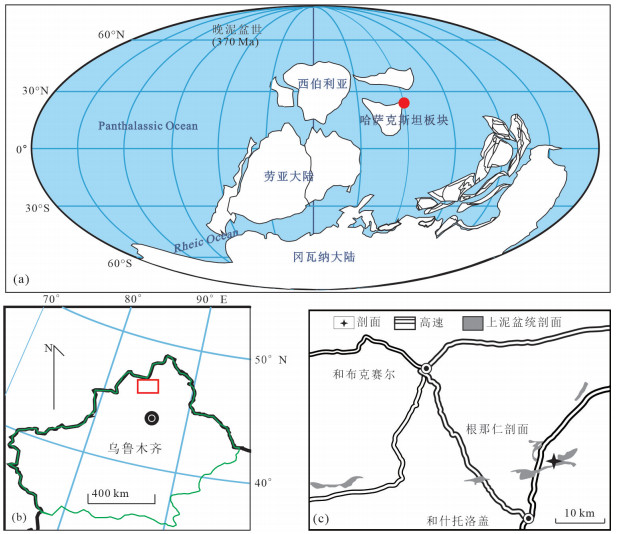
 下载:
下载:
